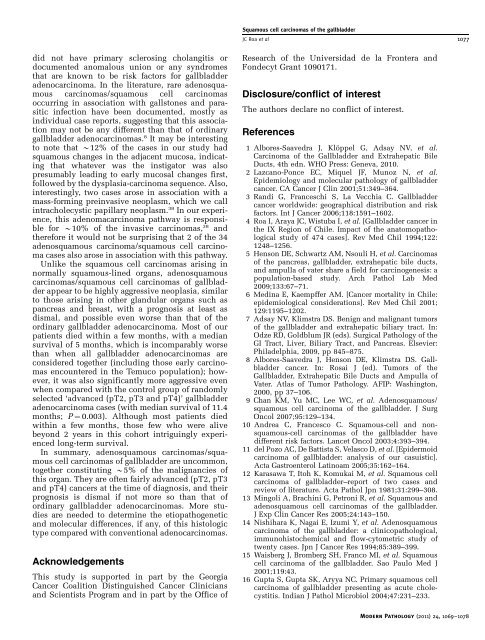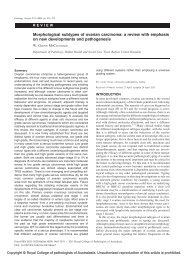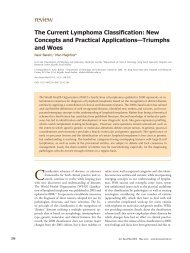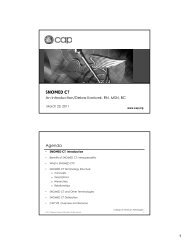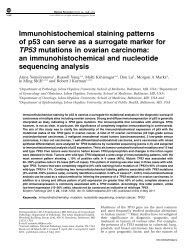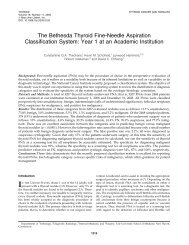Squamous cell and adenosquamous carcinomas of ... - BPA Pathology
Squamous cell and adenosquamous carcinomas of ... - BPA Pathology
Squamous cell and adenosquamous carcinomas of ... - BPA Pathology
Create successful ePaper yourself
Turn your PDF publications into a flip-book with our unique Google optimized e-Paper software.
<strong>Squamous</strong> <strong>cell</strong> <strong>carcinomas</strong> <strong>of</strong> the gallbladder<br />
JC Roa et al 1077<br />
did not have primary sclerosing cholangitis or<br />
documented anomalous union or any syndromes<br />
that are known to be risk factors for gallbladder<br />
adenocarcinoma. In the literature, rare <strong>adenosquamous</strong><br />
<strong>carcinomas</strong>/squamous <strong>cell</strong> <strong>carcinomas</strong><br />
occurring in association with gallstones <strong>and</strong> parasitic<br />
infection have been documented, mostly as<br />
individual case reports, suggesting that this association<br />
may not be any different than that <strong>of</strong> ordinary<br />
gallbladder adeno<strong>carcinomas</strong>. 8 It may be interesting<br />
to note that B12% <strong>of</strong> the cases in our study had<br />
squamous changes in the adjacent mucosa, indicating<br />
that whatever was the instigator was also<br />
presumably leading to early mucosal changes first,<br />
followed by the dysplasia-carcinoma sequence. Also,<br />
interestingly, two cases arose in association with a<br />
mass-forming preinvasive neoplasm, which we call<br />
intracholecystic papillary neoplasm. 38 In our experience,<br />
this adenomacarcinoma pathway is responsible<br />
for B10% <strong>of</strong> the invasive <strong>carcinomas</strong>, 38 <strong>and</strong><br />
therefore it would not be surprising that 2 <strong>of</strong> the 34<br />
<strong>adenosquamous</strong> carcinoma/squamous <strong>cell</strong> carcinoma<br />
cases also arose in association with this pathway.<br />
Unlike the squamous <strong>cell</strong> <strong>carcinomas</strong> arising in<br />
normally squamous-lined organs, <strong>adenosquamous</strong><br />
<strong>carcinomas</strong>/squamous <strong>cell</strong> <strong>carcinomas</strong> <strong>of</strong> gallbladder<br />
appear to be highly aggressive neoplasia, similar<br />
to those arising in other gl<strong>and</strong>ular organs such as<br />
pancreas <strong>and</strong> breast, with a prognosis at least as<br />
dismal, <strong>and</strong> possible even worse than that <strong>of</strong> the<br />
ordinary gallbladder adenocarcinoma. Most <strong>of</strong> our<br />
patients died within a few months, with a median<br />
survival <strong>of</strong> 5 months, which is incomparably worse<br />
than when all gallbladder adeno<strong>carcinomas</strong> are<br />
considered together (including those early <strong>carcinomas</strong><br />
encountered in the Temuco population); however,<br />
it was also significantly more aggressive even<br />
when compared with the control group <strong>of</strong> r<strong>and</strong>omly<br />
selected ‘advanced (pT2, pT3 <strong>and</strong> pT4)’ gallbladder<br />
adenocarcinoma cases (with median survival <strong>of</strong> 11.4<br />
months; P ¼ 0.003). Although most patients died<br />
within a few months, those few who were alive<br />
beyond 2 years in this cohort intriguingly experienced<br />
long-term survival.<br />
In summary, <strong>adenosquamous</strong> <strong>carcinomas</strong>/squamous<br />
<strong>cell</strong> <strong>carcinomas</strong> <strong>of</strong> gallbladder are uncommon,<br />
together constituting B5% <strong>of</strong> the malignancies <strong>of</strong><br />
this organ. They are <strong>of</strong>ten fairly advanced (pT2, pT3<br />
<strong>and</strong> pT4) cancers at the time <strong>of</strong> diagnosis, <strong>and</strong> their<br />
prognosis is dismal if not more so than that <strong>of</strong><br />
ordinary gallbladder adeno<strong>carcinomas</strong>. More studies<br />
are needed to determine the etiopathogenetic<br />
<strong>and</strong> molecular differences, if any, <strong>of</strong> this histologic<br />
type compared with conventional adeno<strong>carcinomas</strong>.<br />
Acknowledgements<br />
This study is supported in part by the Georgia<br />
Cancer Coalition Distinguished Cancer Clinicians<br />
<strong>and</strong> Scientists Program <strong>and</strong> in part by the Office <strong>of</strong><br />
Research <strong>of</strong> the Universidad de la Frontera <strong>and</strong><br />
Fondecyt Grant 1090171.<br />
Disclosure/conflict <strong>of</strong> interest<br />
The authors declare no conflict <strong>of</strong> interest.<br />
References<br />
1 Albores-Saavedra J, Klöppel G, Adsay NV, et al.<br />
Carcinoma <strong>of</strong> the Gallbladder <strong>and</strong> Extrahepatic Bile<br />
Ducts, 4th edn. WHO Press: Geneva, 2010.<br />
2 Lazcano-Ponce EC, Miquel JF, Munoz N, et al.<br />
Epidemiology <strong>and</strong> molecular pathology <strong>of</strong> gallbladder<br />
cancer. CA Cancer J Clin 2001;51:349–364.<br />
3 R<strong>and</strong>i G, Franceschi S, La Vecchia C. Gallbladder<br />
cancer worldwide: geographical distribution <strong>and</strong> risk<br />
factors. Int J Cancer 2006;118:1591–1602.<br />
4 Roa I, Araya JC, Wistuba I, et al. [Gallbladder cancer in<br />
the IX Region <strong>of</strong> Chile. Impact <strong>of</strong> the anatomopathological<br />
study <strong>of</strong> 474 cases]. Rev Med Chil 1994;122:<br />
1248–1256.<br />
5 Henson DE, Schwartz AM, Nsouli H, et al. Carcinomas<br />
<strong>of</strong> the pancreas, gallbladder, extrahepatic bile ducts,<br />
<strong>and</strong> ampulla <strong>of</strong> vater share a field for carcinogenesis: a<br />
population-based study. Arch Pathol Lab Med<br />
2009;133:67–71.<br />
6 Medina E, Kaempffer AM. [Cancer mortality in Chile:<br />
epidemiological considerations]. Rev Med Chil 2001;<br />
129:1195–1202.<br />
7 Adsay NV, Klimstra DS. Benign <strong>and</strong> malignant tumors<br />
<strong>of</strong> the gallbladder <strong>and</strong> extrahepatic biliary tract. In:<br />
Odze RD, Goldblum JR (eds). Surgical <strong>Pathology</strong> <strong>of</strong> the<br />
GI Tract, Liver, Biliary Tract, <strong>and</strong> Pancreas. Elsevier:<br />
Philadelphia, 2009, pp 845–875.<br />
8 Albores-Saavedra J, Henson DE, Klimstra DS. Gallbladder<br />
cancer. In: Rosai J (ed). Tumors <strong>of</strong> the<br />
Gallbladder, Extrahepatic Bile Ducts <strong>and</strong> Ampulla <strong>of</strong><br />
Vater. Atlas <strong>of</strong> Tumor <strong>Pathology</strong>. AFIP: Washington,<br />
2000, pp 37–106.<br />
9 Chan KM, Yu MC, Lee WC, et al. Adenosquamous/<br />
squamous <strong>cell</strong> carcinoma <strong>of</strong> the gallbladder. J Surg<br />
Oncol 2007;95:129–134.<br />
10 Andrea C, Francesco C. <strong>Squamous</strong>-<strong>cell</strong> <strong>and</strong> nonsquamous-<strong>cell</strong><br />
<strong>carcinomas</strong> <strong>of</strong> the gallbladder have<br />
different risk factors. Lancet Oncol 2003;4:393–394.<br />
11 del Pozo AC, De Battista S, Velasco D, et al. [Epidermoid<br />
carcinoma <strong>of</strong> gallbladder: analysis <strong>of</strong> our casuistic].<br />
Acta Gastroenterol Latinoam 2005;35:162–164.<br />
12 Karasawa T, Itoh K, Komukai M, et al. <strong>Squamous</strong> <strong>cell</strong><br />
carcinoma <strong>of</strong> gallbladder–report <strong>of</strong> two cases <strong>and</strong><br />
review <strong>of</strong> literature. Acta Pathol Jpn 1981;31:299–308.<br />
13 Mingoli A, Brachini G, Petroni R, et al. <strong>Squamous</strong> <strong>and</strong><br />
<strong>adenosquamous</strong> <strong>cell</strong> <strong>carcinomas</strong> <strong>of</strong> the gallbladder.<br />
J Exp Clin Cancer Res 2005;24:143–150.<br />
14 Nishihara K, Nagai E, Izumi Y, et al. Adenosquamous<br />
carcinoma <strong>of</strong> the gallbladder: a clinicopathological,<br />
immunohistochemical <strong>and</strong> flow-cytometric study <strong>of</strong><br />
twenty cases. Jpn J Cancer Res 1994;85:389–399.<br />
15 Waisberg J, Bromberg SH, Franco MI, et al. <strong>Squamous</strong><br />
<strong>cell</strong> carcinoma <strong>of</strong> the gallbladder. Sao Paulo Med J<br />
2001;119:43.<br />
16 Gupta S, Gupta SK, Aryya NC. Primary squamous <strong>cell</strong><br />
carcinoma <strong>of</strong> gallbladder presenting as acute cholecystitis.<br />
Indian J Pathol Microbiol 2004;47:231–233.<br />
Modern <strong>Pathology</strong> (2011) 24, 1069–1078


